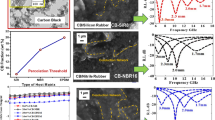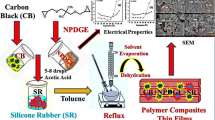Abstract
CCTO–silicone rubber composites with different CCTO mass fractions have been prepared. SEM images show that CCTO particles distribute evenly in silicone rubber matrix. The experimental results reveal that the composites possess excellent mechanical and dielectric properties. The dielectric constant of the composites has been simulated in the light of two different theoretical models which can almost properly predict the experimental values for the composites except when the mass fraction of CCTO increases beyond 30 %, the experimental values begin to slightly deviate down from the predicted ones. Both the dielectric constant and loss values increase with the increase of uniaxial pressure applied on the composites. For the composite with CCTO mass fraction of 50 % under the pressure of 4 MPa, its dielectric constant value has been improved by about three times, but its loss value has been raised by less than twice that of the composites without pressure. Therefore, the dependence of dielectric constant on pressure makes it a new promising material in practical applications as capacitance sensors and other electronic devices.








Similar content being viewed by others
References
X. Liu, C. Xiong, H. Sun, L. Dong, R. Li, Y. Liu, Mat. Sci. Eng. B-Solid 127, 261–265 (2006)
Z. Kutnjak, B. Vodopivec, D. Kuščer, M. Kosec, V. Bobnar, B. Hilczer, J. Non-Cryst. Solids 351, 1261–1265 (2005)
S. Xie, B. Zhu, X. Wei, Z. Xu, Y.-Y. Xu, Compos. Part A-Appl. Sci 36, 1152–1157 (2005)
K.H. Lam, H.L.W. Chan, H.S. Luo, Q.R. Yin, Z.W. Yin, C.L. Choy, Microelectro. Eng. 66, 792–797 (2003)
X.X. Wang, K.H. Lam, X.G. Tang, H.L.W. Chan, Solid State Commun. 130, 695–699 (2004)
Z. Dang, C. Nan, Ceram. Int. 31, 349–351 (2005)
F. Chao, G. Liang, W. Kong, X. Zhang, Mater. Chem. Phys. 108, 306–311 (2008)
Y. Bai, Z.Y. Cheng, V. Bharti, H.S. Xu, Q.M. Zhang, Appl. Phys. Lett. 25(76), 3804–3806 (2000)
F. Chao, G. Liang, W. Kong, Z. Zhang, J. Wang, Polym. Bull. 60, 129–136 (2008)
W. Li, X. Zhijun, R. Chu, F. Peng, J. Hao, J. Alloys Compd. 482, 137–140 (1999)
W. Luan, L. Gao, J. Guo, Ceram. Int. 25, 727–729 (1999)
A.P. Ramirez, M.A. Subramanian, M. Gardel, G. Blumberg, D. Li, T. Vogt, S.M. Shapiro, Solid State Commun. 115, 217–220 (2000)
S.-D. Cho, S.-Y. Lee, J.-G. Hyun, K.-W. Paik, J. Mater. Sci.- Mater. Electron. 16, 77–84 (2005)
S. Babu, K. Singh, A. Govindan, Appl. Phys. A 107, 697–700 (2012)
C.Y. Zhi, Y. Bando, T. Terao, C. Tang, D. Golberg, Pure Appl. Chem. 82(11), 2175–2183 (2010)
R.K. Grubbs, E.L. Venturini, P.G. Clem, J.J. Richardson, B.A. Tuttle, G.A. Samara, Phys. Rev. 72, 104111 (2005)
Acknowledgments
This study is supported by National Natural Science Foundation China (Project No. 11175159) and The Basic Research of Plan on Natural Science of the Education Department of Henan Province (Grant No. 12A140016).
Author information
Authors and Affiliations
Corresponding author
Rights and permissions
About this article
Cite this article
Li, T., Chen, J., Dai, H. et al. Dielectric properties of CaCu3Ti4O12–silicone rubber composites. J Mater Sci: Mater Electron 26, 312–316 (2015). https://doi.org/10.1007/s10854-014-2401-5
Received:
Accepted:
Published:
Issue Date:
DOI: https://doi.org/10.1007/s10854-014-2401-5




